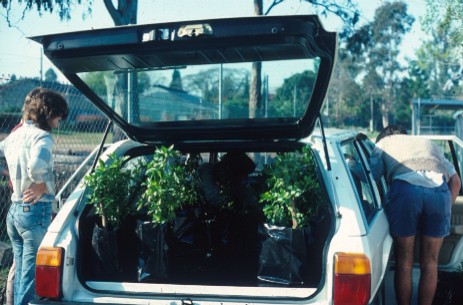|
On the large scale, decisions about where to make releases may be affected by the
following:
 | which areas that have the most serious problems caused by
the weed, |
 | which areas are suitable as nursery sites, |
 | which areas have regional officers or other project
collaborators, |
 | which areas have ecoclimatic conditions best suited to the
agent, |
 | what is the ability of the insect to disperse naturally.
|
The areas that have the most serious problems caused by
the weed.
Release location is often determined by land holder demand and
political pressures as well as suitability of climate, other abiotic considerations and logistics (see below).
|

Host plants with agents ready for transport to release
site.
|
The areas which are suitable as nursery sites.
Where possible, early releases should be made at sites which can be used as nursery or reservoir sites for later field-collection of the agent. For example, high priority could be given to starting a nursery site located near the project headquarters. Besides being a place to collect extra insects if required, the site will provide some
'insurance' against accidental loss of the mass-rearing colony and can serve as a demonstration and evaluation site.
The areas which have regional officers or other project
collaborators.
For obvious reasons, supply of starter colonies to workers who will be helping with rearing and distribution of the agent is recommended at an early stage of the project. Irrespective of whether collaborators intend rearing the agent at nursery sites or in laboratory cages/containers, they should be provided with written notes on the agent's biology and rearing, collecting and shipping advice. At this stage of the project, those involved in importing and testing the agent will know far more about the agent and how to manage it than most of those involved in later rearing and distribution. We have a responsibility to ensure all, as far as possible, are equally well informed. Apparently obvious and basic details could be included in the information provided, even to the extent of including basic advice on keeping shipping and distribution records.
|

Transporting biocontrol agents to a release site by
boat.
|
The areas which have ecoclimatic conditions best suited to the agent.
Knowledge of the weed's distribution, the weed's preferences, discontinuities in its distribution, and geographic barriers to natural spread of the agent should all be considered when selecting release sites. Information gained by matching climates of the
agent's host range and the weed's distribution will also help in making decisions on release priorities. Computer programs such as
CLIMEX may be of use here.
The ability of the insect to disperse naturally.
The natural ability of the agent to disperse may help hasten its distribution within a region. Prevailing winds aid flying insects and light-bodied weak fliers.
For floating aquatic weeds, movement of plants by water currents down a river system can help agent dispersal. In this case, initial releases of the agent should therefore be made onto weed infestations as high up the river system as possible.
[ Next ]
Tony
Wright |

